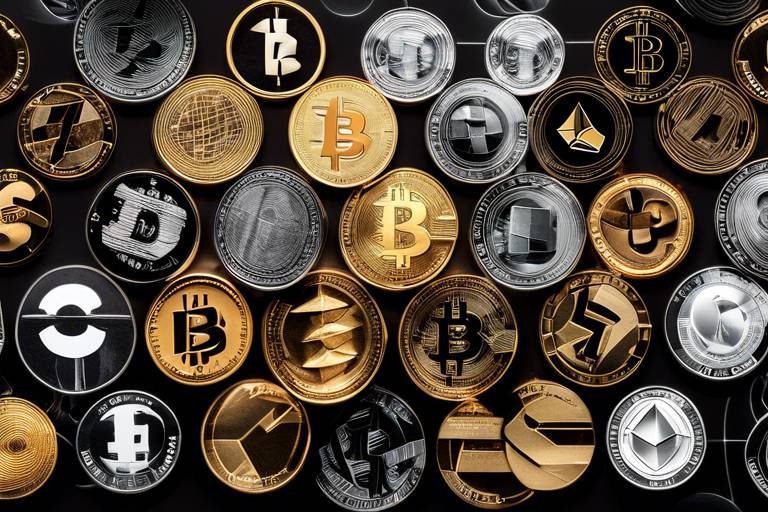The Influence of Mobile Payment Trends on Cryptocurrency
This article explores how the rise of mobile payment systems is shaping the landscape of cryptocurrency, examining trends, challenges, and the potential for future integration in financial ecosystems.
Mobile payment systems have rapidly gained popularity, revolutionizing how consumers transact. With the increasing penetration of smartphones and the internet, people are now more inclined to use their devices for payments rather than traditional cash or card methods. Factors such as convenience, speed, and security have driven this shift. Imagine being able to pay for your morning coffee with just a tap on your phone, without fumbling for cash or cards. This convenience has led to a significant increase in mobile payment adoption, which, in turn, has implications for traditional banking and the world of cryptocurrency.
As mobile payment platforms become mainstream, they significantly influence cryptocurrency adoption. These platforms not only facilitate access to digital currencies but also attract new users who might have been hesitant to dive into the crypto world. Think about it: if you can easily buy Bitcoin or Ethereum through an app you already use for daily transactions, why wouldn't you give it a try? This seamless integration lowers the barrier to entry for many potential users, making cryptocurrency more accessible than ever before.
The integration of mobile payment systems with cryptocurrency wallets enhances user experience. When users can link their mobile payment accounts to their crypto wallets, it allows for seamless transactions that encourage more engagement with cryptocurrencies. For instance, a user could receive payments in Bitcoin and instantly convert it to their local currency via their mobile payment app. This fluidity not only simplifies the user experience but also fosters a sense of confidence in using cryptocurrencies as a viable payment option.
While convenience is a key advantage, security remains a critical concern. Mobile payment systems, although generally secure, are not immune to vulnerabilities. The potential for hacking, phishing, and data breaches can create hesitancy among users. When it comes to cryptocurrency transactions, the stakes are even higher. Users need assurance that their funds are safe and that they can trust the platforms they are using. Therefore, addressing these security concerns is paramount for the continued growth of both mobile payments and cryptocurrency.
Building user trust is essential for the success of mobile payments and cryptocurrencies. Many users still have a limited understanding of how cryptocurrencies work, which can lead to skepticism. Education plays a crucial role in fostering confidence among users. By providing clear information about how to use mobile payment systems and cryptocurrencies securely, providers can help demystify the process. Initiatives such as online tutorials, webinars, and community outreach can significantly enhance user knowledge and trust.
The rise of mobile payment systems presents various regulatory challenges for cryptocurrencies. As governments and regulatory bodies scramble to keep up with the rapid evolution of financial technology, the legal landscape is constantly changing. This can create uncertainty for users and providers alike. Understanding the regulations that govern both mobile payments and cryptocurrencies is essential for navigating this complex environment. Staying informed about changes can help users make better decisions regarding their financial activities.
Looking ahead, the convergence of mobile payments and cryptocurrency is likely to evolve in exciting ways. Emerging trends such as the integration of artificial intelligence and blockchain technology could shape this dynamic relationship. As these technologies develop, they may offer new features that enhance user experience and security.
The integration of mobile payments with decentralized finance (DeFi) platforms could revolutionize finance. Imagine being able to lend, borrow, and earn interest on your assets directly from your mobile device, all without needing a traditional bank. This synergy could enhance accessibility and innovation in the financial sector, allowing users to take control of their financial futures in ways never before possible.
As mobile payment systems expand globally, their influence on cryptocurrency markets will grow. Emerging markets, where traditional banking infrastructure is limited, present a significant opportunity for mobile payment and cryptocurrency integration. Countries in Africa and Asia, for example, are seeing a surge in mobile payment adoption, which could lead to increased cryptocurrency usage as well. The role of mobile payments in driving this growth cannot be overstated, as they pave the way for a more inclusive financial ecosystem.
- What are mobile payment systems? Mobile payment systems allow users to make transactions using their smartphones or other mobile devices, often through apps or digital wallets.
- How do mobile payments influence cryptocurrency adoption? They provide a convenient and accessible way for users to engage with cryptocurrencies, lowering the barriers to entry.
- What are the security concerns associated with mobile payments and cryptocurrencies? Key concerns include hacking, phishing, and data breaches, which can undermine user trust.
- How can users build trust in mobile payment systems and cryptocurrencies? Education and transparency from providers can help users understand how to use these systems securely.
- What does the future hold for mobile payments and cryptocurrencies? The integration of new technologies and global market expansion may lead to greater accessibility and innovation.

Emergence of Mobile Payment Systems
The world of finance is undergoing a seismic shift, thanks to the . Imagine carrying your entire wallet in your pocket, but instead of cash and cards, you have an app that allows you to pay for anything with just a tap. This is not just a futuristic dream; it's the reality we live in today. The rapid adoption of mobile payment platforms like Apple Pay, Google Wallet, and Venmo has revolutionized how consumers transact, making payments faster, easier, and more convenient than ever before.
Several factors are driving this remarkable trend. First and foremost, the proliferation of smartphones has put powerful computing devices in the hands of billions of people worldwide. With just a few taps, users can send money, pay bills, or even split a dinner bill with friends. This convenience is a game changer, especially for younger generations who are less inclined to carry cash or cards. Additionally, the rise of e-commerce has necessitated smoother and quicker payment solutions, further propelling the popularity of mobile payments.
Moreover, the COVID-19 pandemic has accelerated this trend. As people sought contactless payment options to minimize physical interactions, mobile payments surged. Businesses had to adapt quickly, integrating mobile payment systems into their operations to meet consumer demand. For many, this shift was not just a temporary fix but a long-term strategy to stay relevant in a rapidly changing market.
But what does this mean for traditional banking? The implications are profound. Traditional banks are starting to feel the heat as mobile payment systems offer an alternative that is often more user-friendly and accessible. As a result, many banks are now investing heavily in their mobile applications, trying to keep pace with the tech-savvy companies that are leading the charge in this space.
In essence, the emergence of mobile payment systems is not just reshaping how we pay; it's also altering the landscape of finance itself. As these systems continue to evolve, they will likely have a significant impact on the adoption of cryptocurrencies. With more people becoming comfortable with digital transactions, the stage is set for a seamless integration of mobile payments and cryptocurrencies, creating a financial ecosystem that is more inclusive and innovative than ever before.

Impact on Cryptocurrency Adoption
The rise of mobile payment platforms has sparked a revolution in how we view and use money, and this shift is significantly impacting the adoption of cryptocurrency. As more people become accustomed to the convenience of mobile transactions, they are also becoming more open to the idea of using digital currencies. This transition is not just about technology; it’s about changing perceptions and behaviors. Imagine walking into a store, scanning your phone, and completing a purchase in seconds—this seamless experience is what mobile payments offer, and it’s paving the way for cryptocurrencies to enter the mainstream.
One of the most significant ways mobile payment systems are facilitating cryptocurrency adoption is by lowering barriers to entry. Traditionally, acquiring cryptocurrency required navigating complex exchanges, creating wallets, and understanding blockchain technology. However, mobile payment platforms simplify this process. Users can now buy, sell, and trade cryptocurrencies directly from their phones with just a few taps. This accessibility is crucial for attracting new users who may have previously felt intimidated by the crypto space.
Furthermore, mobile payment apps often include features that educate users about cryptocurrencies. For example, many platforms provide tutorials, tips, and even simulated environments where users can practice trading without financial risk. This educational aspect is vital in demystifying digital currencies, making them more approachable for the average consumer. As users become more informed about how cryptocurrencies work, their confidence grows, leading to increased adoption rates.
In addition, the integration of mobile payments with cryptocurrency wallets presents a unique opportunity for innovation. By allowing users to manage both traditional and digital currencies from a single interface, these platforms create a cohesive financial ecosystem. Imagine a world where you can pay for your coffee with Bitcoin, seamlessly transitioning between your fiat and crypto balances. This level of integration not only enhances user experience but also encourages individuals to experiment with cryptocurrencies as part of their everyday transactions.
However, the impact of mobile payment systems on cryptocurrency adoption is not without its challenges. For instance, while convenience is a significant draw, some users remain skeptical about the security of mobile transactions. Concerns about hacking, fraud, and the safety of personal data can deter potential users from engaging with cryptocurrencies. Addressing these security concerns is essential for fostering trust and encouraging wider adoption.
Moreover, as mobile payment systems continue to evolve, they may also face regulatory scrutiny. Governments around the world are grappling with how to regulate digital currencies, and this uncertainty can create hesitance among users. If regulations are too strict or unclear, they may stifle innovation and discourage individuals from exploring cryptocurrency options. Thus, it’s crucial for both mobile payment providers and cryptocurrency platforms to work together to navigate these regulatory landscapes effectively.
In conclusion, the impact of mobile payment systems on cryptocurrency adoption is profound and multifaceted. By simplifying access, enhancing user education, and integrating digital currencies into everyday transactions, these platforms are not just changing how we pay but also how we perceive and engage with the world of cryptocurrency. As this trend continues, we can expect to see an increase in the number of users embracing digital currencies, leading to a more integrated financial future.
- How do mobile payments facilitate cryptocurrency adoption? Mobile payments simplify the process of buying and using cryptocurrencies, making them more accessible to everyday users.
- What security concerns are associated with mobile payments and cryptocurrencies? Users often worry about hacking, fraud, and the safety of their personal data when using mobile payment platforms for cryptocurrency transactions.
- Can mobile payment systems integrate with cryptocurrency wallets? Yes, many mobile payment platforms are now offering integrated solutions that allow users to manage both fiat and digital currencies seamlessly.
- What role does education play in cryptocurrency adoption? Education is crucial in demystifying cryptocurrencies and building user confidence, which can lead to increased adoption rates.

Integration with Existing Wallets
The integration of mobile payment systems with existing cryptocurrency wallets is a game-changer in the digital finance landscape. Imagine a world where sending and receiving digital currencies is as easy as tapping your smartphone screen. This seamless interaction not only enhances user experience but also lowers the barrier to entry for newcomers to the cryptocurrency space. With mobile wallets becoming more user-friendly, they are increasingly appealing to a broader audience, including those who may have previously been hesitant to dive into the world of cryptocurrencies.
One of the most significant advantages of this integration is the convenience it offers. Users can manage both their fiat currencies and cryptocurrencies within a single app, simplifying their financial transactions. For instance, a user can easily convert their Bitcoin into local currency to make a purchase or pay for services without needing to switch between multiple apps. This level of accessibility is crucial in attracting users who value efficiency in their financial dealings.
Furthermore, the integration fosters a sense of trust among users. When people see familiar mobile payment interfaces combined with cryptocurrency functionalities, they are more likely to engage with digital currencies. This trust is built on the premise that mobile payment systems are already established and secure, making the leap into cryptocurrency seem less daunting. As a result, we are likely to see a significant uptick in the number of users willing to explore and invest in cryptocurrencies.
However, it is essential to note that not all integrations are created equal. Some wallets may offer limited features or lack essential security measures, which can deter users. To ensure a positive experience, users should look for wallets that provide:
- Multi-currency support: The ability to hold various cryptocurrencies and fiat currencies.
- Security features: Two-factor authentication, biometric logins, and encryption.
- User-friendly interfaces: Intuitive designs that make navigation simple for all users.
In addition, as mobile payment systems continue to evolve, we can expect further enhancements in wallet functionalities. The incorporation of advanced technologies such as artificial intelligence and machine learning could lead to personalized financial advice and transaction recommendations, making the experience even more tailored to individual user needs.
Ultimately, the integration of mobile payment systems with existing cryptocurrency wallets is not just about convenience; it’s about creating a holistic financial ecosystem that empowers users. By streamlining the process of using cryptocurrencies alongside traditional payment methods, we are paving the way for a future where digital currencies are a common part of everyday transactions. As this integration deepens, we will likely witness a surge in cryptocurrency adoption, driven by the simplicity and efficiency that mobile payment systems offer.

Security Concerns
As the world becomes increasingly reliant on mobile payment systems, are rising to the forefront of discussions surrounding their adoption and integration with cryptocurrencies. While these payment methods offer unparalleled convenience, they also introduce various vulnerabilities that can jeopardize users' financial data and assets. For instance, mobile devices are often targets for hackers who exploit weaknesses in app security or use phishing techniques to gain access to sensitive information.
Moreover, the nature of mobile payments—where transactions are conducted quickly and often without robust verification—can lead to fraudulent activities. Users may inadvertently expose themselves to risks by using public Wi-Fi networks or by failing to update their payment apps regularly. It's crucial for users to understand that while mobile payments can facilitate quick access to cryptocurrency, they must also be vigilant about their security practices.
To illustrate the potential security issues, consider the following table that outlines common vulnerabilities associated with mobile payment systems:
| Vulnerability | Description | Potential Impact |
|---|---|---|
| Weak Authentication | Inadequate verification processes, such as simple passwords or lack of two-factor authentication. | Unauthorized access to accounts and funds. |
| Malware | Malicious software that can infiltrate mobile devices and capture sensitive information. | Loss of funds and personal data. |
| Phishing Attacks | Scams that trick users into providing their login credentials through fake websites or messages. | Identity theft and financial loss. |
In addition to understanding these vulnerabilities, users must take proactive steps to safeguard their mobile payment experiences. Some effective strategies include:
- Enabling Two-Factor Authentication: This adds an extra layer of security by requiring a second form of verification.
- Regularly Updating Apps: Keeping payment apps up to date ensures users benefit from the latest security patches.
- Avoiding Public Wi-Fi: Using secure networks can help protect against potential hacks.
Ultimately, while mobile payment systems can significantly enhance the accessibility of cryptocurrencies, users must remain aware of the associated security concerns. By adopting best practices and maintaining a cautious approach, individuals can enjoy the benefits of mobile payments while minimizing risks to their financial well-being.

User Trust and Education
In the rapidly evolving world of mobile payments and cryptocurrencies, user trust is a cornerstone for success. Imagine walking into a store and confidently using your mobile device to pay with a cryptocurrency—sounds futuristic, right? But for this vision to become a reality, users must feel secure and knowledgeable about the technologies they are engaging with. Trust is not built overnight; it requires a combination of transparency, education, and consistent positive experiences.
Education plays a pivotal role in cultivating this trust. Many potential users are hesitant to adopt mobile payment systems or cryptocurrencies due to a lack of understanding. They may feel overwhelmed by technical jargon or fear the risks associated with digital transactions. To bridge this gap, it is essential to provide clear and accessible information about how these systems work, their benefits, and the security measures in place.
Here are a few key areas where education can make a significant impact:
- Understanding Blockchain Technology: Educating users about the underlying technology of cryptocurrencies can demystify the process and highlight its security features.
- Security Best Practices: Informing users about how to protect their digital assets, such as using two-factor authentication and recognizing phishing attempts, can enhance their confidence.
- Regulatory Compliance: Providing insights into the legal landscape surrounding mobile payments and cryptocurrencies can reassure users that they are engaging with legitimate and regulated platforms.
Furthermore, businesses and service providers must engage in proactive communication. Regularly updating users about new features, security upgrades, and educational resources can foster a sense of community and trust. For instance, hosting webinars, creating informative blog posts, or even utilizing social media to share tips and insights can empower users. Imagine a world where users feel so informed that they not only trust mobile payments and cryptocurrencies but also advocate for their use among friends and family. This is the kind of ripple effect that education can create.
In conclusion, building user trust through education is not just beneficial; it is essential for the future of mobile payments and cryptocurrencies. By investing in user education and transparent communication, we can pave the way for a more inclusive financial ecosystem where everyone feels empowered to participate. After all, a well-informed user is not just a user; they are an advocate, a supporter, and a key player in the evolution of digital finance.

Regulatory Challenges
The rise of mobile payment systems has undoubtedly transformed the financial landscape, but it also brings forth a myriad of that cannot be overlooked. As governments and financial authorities scramble to keep pace with technological advancements, the regulatory framework surrounding both mobile payments and cryptocurrencies is often left in a state of flux. This creates a complex environment for users and providers alike, leading to uncertainty and potential barriers to adoption.
One of the primary challenges is the lack of a unified regulatory approach. Different countries have varying stances on how cryptocurrencies should be regulated, which can create confusion for users who wish to engage in cross-border transactions. For instance, while some nations embrace cryptocurrencies and mobile payment innovations, others impose stringent restrictions or outright bans. This inconsistency can hinder the growth of cryptocurrencies, as users may be wary of navigating a patchwork of regulations.
Moreover, the integration of mobile payments with cryptocurrencies raises questions about compliance with existing financial regulations. Mobile payment providers often need to adhere to Anti-Money Laundering (AML) and Know Your Customer (KYC) regulations. However, when these providers attempt to incorporate cryptocurrencies, they may find themselves facing additional scrutiny from regulators who are still trying to understand the implications of digital currencies. This can lead to a situation where innovation is stifled by regulatory hurdles, ultimately affecting the user experience.
Another significant concern is the potential for fraud and abuse. The anonymity and decentralization features of cryptocurrencies can make them attractive for illicit activities, such as money laundering or tax evasion. As mobile payment systems become more intertwined with cryptocurrencies, regulators are increasingly focused on ensuring that these platforms do not facilitate illegal transactions. This heightened scrutiny can lead to more stringent regulations, which may deter users from engaging with cryptocurrencies altogether.
To illustrate the regulatory landscape, consider the following table that outlines key regulatory approaches in various regions:
| Region | Regulatory Approach |
|---|---|
| United States | Mixed; state and federal regulations vary |
| European Union | Progressive; developing a comprehensive regulatory framework |
| China | Restrictive; significant bans on cryptocurrency trading |
| Japan | Supportive; recognized as legal tender with regulations |
As we navigate these regulatory challenges, it becomes evident that building a robust framework is essential for the future of mobile payments and cryptocurrency. Collaboration between regulators, payment providers, and cryptocurrency platforms is crucial to create an environment that fosters innovation while ensuring user protection. Only through dialogue and cooperation can we hope to strike a balance that promotes growth without compromising security.
In conclusion, the road ahead is fraught with challenges, but it also presents opportunities for growth and innovation. As mobile payment systems continue to evolve and integrate with cryptocurrencies, staying informed about regulatory developments will be vital for users and providers alike. After all, understanding the rules of the game can empower users to make informed decisions in this rapidly changing financial landscape.
- What are the main regulatory challenges facing mobile payments and cryptocurrencies? The main challenges include a lack of unified regulations across different regions, compliance with AML and KYC requirements, and concerns about fraud and abuse.
- How do different countries regulate cryptocurrencies? Regulations vary significantly, with some countries embracing cryptocurrencies and others imposing strict bans or restrictions.
- Why is user education important in this context? Educating users about regulations and security measures can help build trust and confidence in using mobile payment systems and cryptocurrencies.

Future Trends in Mobile Payments and Cryptocurrency
The intersection of mobile payments and cryptocurrency is not just a fleeting trend; it's a burgeoning revolution that promises to reshape the financial landscape. As we look towards the future, several key trends are emerging that will likely define how consumers and businesses engage with both mobile payment systems and digital currencies. One of the most exciting developments is the increasing integration of Decentralized Finance (DeFi) platforms with mobile payment solutions. Imagine a world where you can seamlessly transfer your crypto assets to pay for everyday purchases, all from the convenience of your smartphone. This integration could significantly enhance accessibility, allowing users to engage with financial services that were previously out of reach.
Moreover, the rapid expansion of mobile payment systems across the globe is set to amplify their influence on cryptocurrency markets. As more people gain access to smartphones and mobile banking, the potential user base for cryptocurrencies expands exponentially. Countries with underdeveloped banking infrastructure may leapfrog traditional banking entirely, opting instead for mobile payment solutions that incorporate digital currencies. This shift could lead to a more inclusive financial ecosystem, where anyone with a smartphone can participate in the global economy.
However, with great opportunity comes great responsibility. The evolving landscape of regulations surrounding mobile payments and cryptocurrencies is a double-edged sword. On one hand, clear regulatory frameworks can foster innovation and build consumer trust; on the other hand, overly stringent regulations could stifle growth and limit the potential of these technologies. As governments and regulatory bodies grapple with how to approach this new frontier, it will be crucial for stakeholders to advocate for balanced policies that encourage innovation while ensuring consumer protection.
Additionally, the rise of Artificial Intelligence (AI) in mobile payment systems is another trend to watch. AI can enhance fraud detection and improve user experience through personalized recommendations. Imagine receiving tailored suggestions on which cryptocurrencies to invest in based on your spending habits or risk tolerance. This level of personalization could make cryptocurrency investing more approachable for the average consumer, demystifying the complexities of the market.
As we navigate this dynamic landscape, it's essential to consider the role of user education in fostering a smooth transition into this new era. Many consumers still harbor skepticism about cryptocurrencies, often due to a lack of understanding. Therefore, educational initiatives that explain how mobile payments and cryptocurrencies work together will be vital. Workshops, online courses, and community outreach programs could play a significant role in building confidence among users, encouraging them to embrace these technologies.
In conclusion, the future of mobile payments and cryptocurrency is bright, filled with potential and challenges alike. The trends we are witnessing today are merely the tip of the iceberg. As technology evolves and consumer behavior shifts, we can expect to see even more innovative solutions that integrate these two powerful financial tools. The key will be to navigate this landscape with an eye towards inclusivity, security, and education, ensuring that everyone can benefit from the advantages that mobile payments and cryptocurrencies have to offer.
- What is the relationship between mobile payments and cryptocurrency?
Mobile payments provide a convenient way to transact using digital currencies, enabling users to easily buy, sell, and exchange cryptocurrencies. - How can DeFi platforms enhance mobile payment systems?
DeFi platforms can offer innovative financial services through mobile apps, allowing users to lend, borrow, and earn interest on their crypto assets seamlessly. - What role does user education play in cryptocurrency adoption?
Education helps demystify cryptocurrencies, building trust and confidence among users, which is essential for widespread adoption.

Decentralized Finance (DeFi) Integration
The integration of mobile payments with Decentralized Finance (DeFi) platforms is not just a trend; it's a revolution in the financial landscape. Imagine a world where you can send money, trade assets, and earn interest on your holdings, all from your mobile device, without the need for traditional banks. This synergy between mobile payments and DeFi is reshaping how we think about finance, making it more accessible and user-friendly.
The appeal of DeFi lies in its decentralization, which eliminates the need for intermediaries. This means that users can interact directly with financial services, such as lending, borrowing, and trading, through smart contracts on blockchain networks. The integration of mobile payment systems into this ecosystem allows users to easily engage with DeFi platforms, enabling them to make transactions on-the-go. Imagine being able to lend your cryptocurrency while sipping coffee at your favorite café!
Furthermore, the user experience is significantly enhanced when mobile payment systems are integrated with DeFi applications. For instance, users can seamlessly transfer funds from their mobile wallets to DeFi platforms without the cumbersome process of transferring to a traditional bank account first. This not only saves time but also reduces the friction often associated with cryptocurrency transactions.
However, it’s essential to address the potential challenges that come with this integration. Security remains a paramount concern. With the rise of mobile payment systems, hackers are increasingly targeting these platforms, looking for vulnerabilities. Users must be educated on best practices for securing their assets, such as using two-factor authentication and understanding the risks associated with smart contracts. A robust security framework is vital to ensure that the integration of mobile payments and DeFi remains a safe and reliable option for users.
In conclusion, the integration of mobile payments with DeFi is paving the way for a more inclusive financial ecosystem. It allows users to harness the power of blockchain technology while enjoying the convenience of mobile transactions. As this integration continues to evolve, we can expect to see a surge in user engagement and innovation in the financial sector. The future of finance is indeed mobile, decentralized, and incredibly exciting!
- What is Decentralized Finance (DeFi)?
DeFi refers to a financial system built on blockchain technology that allows users to engage in financial transactions without intermediaries, using smart contracts. - How do mobile payments enhance DeFi?
Mobile payments provide a convenient way for users to interact with DeFi platforms, enabling quick and easy transactions directly from their smartphones. - Are mobile payments secure for DeFi transactions?
While mobile payments offer convenience, users should practice good security hygiene, such as using two-factor authentication and being aware of potential risks. - What are the benefits of integrating mobile payments with DeFi?
The integration enhances user experience, reduces transaction times, and makes financial services more accessible to a broader audience.

Global Adoption and Market Expansion
The global landscape of mobile payments is expanding at a breakneck pace, and this rapid growth is significantly impacting the cryptocurrency market. With more people around the world gaining access to smartphones and the internet, mobile payment systems are becoming the go-to method for transactions. This shift is not just a trend; it’s a revolution that is reshaping how we think about money. As mobile payment platforms gain traction in emerging markets, they are paving the way for a new wave of cryptocurrency adoption.
Consider this: in regions where traditional banking infrastructure is limited, mobile payment systems are stepping in to fill the gap. Countries in Africa, for example, have seen a surge in mobile payment usage, with platforms like M-Pesa leading the charge. This has opened the door for cryptocurrencies to enter these markets, offering users an alternative to conventional financial systems. The ability to transact digitally without the need for a bank account is a game-changer, and it’s driving the demand for cryptocurrencies that can be easily integrated into these mobile ecosystems.
Moreover, the synergy between mobile payments and cryptocurrencies is not just limited to accessibility. As mobile payment platforms evolve, they are increasingly incorporating cryptocurrency features. For instance, some apps now allow users to buy, sell, and store cryptocurrencies directly within their mobile wallets. This seamless integration is crucial for attracting new users who may be hesitant to engage with cryptocurrencies due to perceived complexities. By simplifying the process, mobile payment systems are effectively lowering the barriers to entry for potential cryptocurrency investors.
However, this expansion is not without its challenges. Regulatory hurdles remain a significant concern as governments around the world grapple with how to manage the intersection of mobile payments and cryptocurrencies. Different countries have varying degrees of acceptance and regulation, which can create confusion for users. For example, while some nations actively promote the use of cryptocurrencies, others impose strict regulations or outright bans. This inconsistency can hinder the growth of both mobile payment systems and cryptocurrency adoption.
In light of these challenges, the future looks promising. As mobile payment systems continue to expand globally, they will likely bring cryptocurrencies along for the ride. The potential for market expansion is enormous, especially in regions where financial services are still developing. According to recent studies, the mobile payment market is projected to reach over $12 trillion by 2025, with a significant portion of this growth driven by the integration of cryptocurrencies.
To illustrate the potential market expansion, consider the following table that outlines key regions and their projected growth in mobile payment adoption:
| Region | Projected Growth Rate (2023-2025) | Potential Cryptocurrency Users |
|---|---|---|
| Africa | 30% | 200 million |
| Asia-Pacific | 25% | 300 million |
| Latin America | 20% | 150 million |
| North America | 15% | 100 million |
This table highlights the vast potential for growth in mobile payment adoption across different regions, each of which presents unique opportunities for cryptocurrency integration. As these markets mature, the relationship between mobile payments and cryptocurrencies will likely deepen, creating a robust ecosystem that benefits both users and providers.
In conclusion, the global adoption of mobile payment systems is not merely a trend; it is a transformative force that is reshaping the financial landscape. As more individuals gain access to mobile technology, the integration of cryptocurrencies into these platforms will become increasingly vital. The interplay between mobile payments and cryptocurrencies will not only enhance user experience but also drive significant market expansion, paving the way for a more inclusive financial future.
- What are mobile payment systems? Mobile payment systems allow users to make transactions using their smartphones or other mobile devices, eliminating the need for cash or physical credit cards.
- How do mobile payments influence cryptocurrency adoption? Mobile payments simplify the process of buying, selling, and using cryptocurrencies, making them more accessible to a broader audience.
- What are some challenges facing mobile payments and cryptocurrencies? Regulatory hurdles and security concerns are significant challenges that both mobile payments and cryptocurrencies face as they grow.
- What is the future of mobile payments and cryptocurrencies? The future looks promising, with increasing integration and adoption expected as technology and regulations evolve.
Frequently Asked Questions
-
What are mobile payment systems?
Mobile payment systems are platforms that allow consumers to make transactions using their smartphones or other mobile devices. They enable users to pay for goods and services electronically, often through apps or digital wallets, making transactions faster and more convenient.
-
How do mobile payment systems influence cryptocurrency adoption?
As mobile payment platforms become mainstream, they simplify access to cryptocurrencies. Users can easily buy, sell, or trade digital currencies directly through their mobile devices, which attracts more people to the crypto space. This ease of use can significantly boost cryptocurrency adoption.
-
What is the role of security in mobile payments and cryptocurrencies?
Security is a major concern when it comes to mobile payments and cryptocurrencies. While these systems offer convenience, they also present vulnerabilities that can be exploited by hackers. It's crucial for users to understand these risks and take necessary precautions to protect their assets.
-
How can users build trust in mobile payments and cryptocurrencies?
Building trust requires transparency and education. Users need to be informed about how these systems work, the security measures in place, and the potential risks involved. This knowledge fosters confidence and encourages more people to engage with mobile payments and cryptocurrencies.
-
What are the regulatory challenges facing mobile payments and cryptocurrencies?
The rise of mobile payment systems brings various regulatory challenges for cryptocurrencies. Governments are still figuring out how to regulate these technologies, which can create uncertainty for users and providers. Staying informed about the evolving legal landscape is essential for anyone involved in this space.
-
What future trends can we expect in mobile payments and cryptocurrency?
Looking ahead, we can anticipate a greater integration of mobile payments with decentralized finance (DeFi) platforms. This could revolutionize how we interact with finance, making it more accessible and innovative. Additionally, as mobile payment systems expand globally, their influence on cryptocurrency markets is expected to grow significantly.
-
How does the integration of DeFi and mobile payments benefit users?
The integration of DeFi with mobile payments can enhance accessibility to financial services. Users can leverage decentralized applications directly from their mobile devices, enabling them to manage their assets, earn interest, and participate in financial activities without traditional banking barriers.
-
What potential markets are there for mobile payments and cryptocurrency expansion?
As mobile payment systems continue to grow, emerging markets in regions like Africa and Southeast Asia present significant opportunities for expansion. These areas often have limited access to traditional banking, making them prime candidates for mobile payment and cryptocurrency adoption.



















